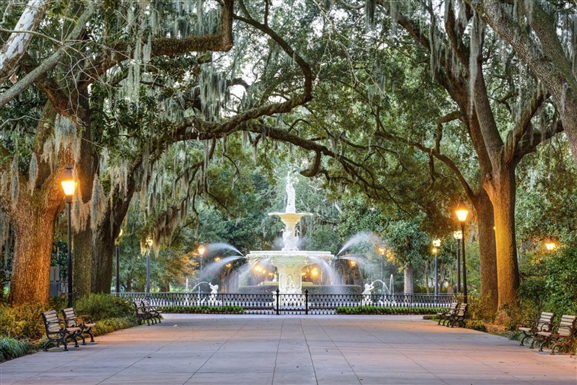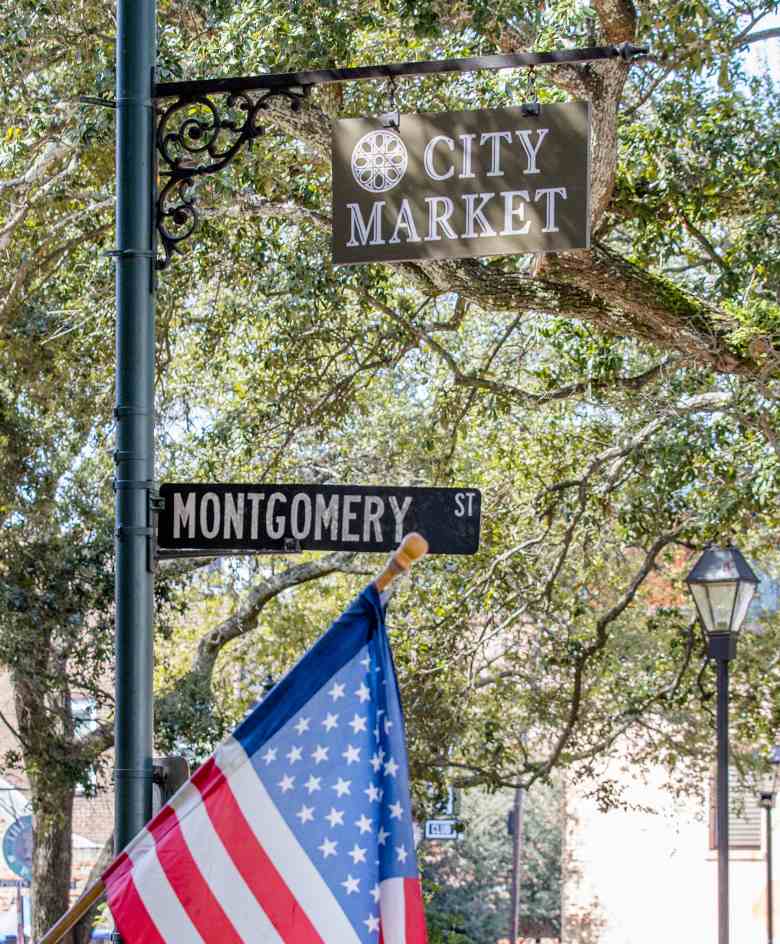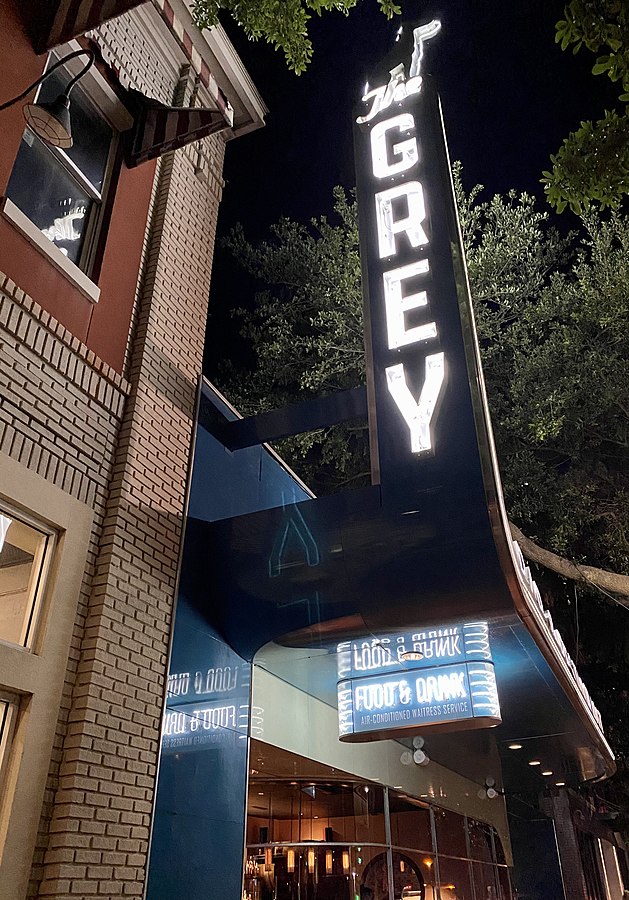Savannah, Georgia
Savannah, Georgia
Savannah is the oldest city in the U.S. state of Georgia and is the county seat of Chatham County. Established in 1733 on the Savannah River, the city of Savannah became the British colonial capital of the Province of Georgia and later the first state capital of Georgia. A strategic port city in the American Revolution and during the American Civil War, Savannah is today an industrial center and an important Atlantic seaport. It is Georgia’s fifth-largest city, with a 2020 U.S. Census population of 147,780. The Savannah metropolitan area, Georgia’s third-largest, had a 2020 population of 404,798.
Each year Savannah attracts millions of visitors to its cobblestone streets, parks, and notable historic buildings. These buildings include the birthplace of Juliette Gordon Low (founder of the Girl Scouts of the USA), the Georgia Historical Society (the oldest continually operating historical society in the South), the Telfair Academy of Arts and Sciences (one of the South’s first public museums), the First African Baptist Church (one of the oldest African-American Baptist congregations in the United States), Temple Mickve Israel (the third-oldest synagogue in the U.S.), and the Central of Georgia Railway roundhouse complex (the oldest standing antebellum rail facility in the U.S.).
Savannah’s downtown area, which includes the Savannah Historic District, the Savannah Victorian Historic District, and 22 parklike squares, is one of the largest National Historic Landmark Districts in the United States (designated by the U.S. government in 1966). Downtown Savannah largely retains the original town plan prescribed by founder James Oglethorpe (a design now known as the Oglethorpe Plan).
Savannah was the host city for the sailing competitions during the 1996 Summer Olympics held in Atlanta.
Things to do in Savannah
Forsyth Park
Forsyth Park is a large city park that occupies 30 acres (0.12 km2) in the historic district of Savannah, Georgia, United States. The park is bordered by Gaston Street on the North, Drayton Street on the East, Park Avenue on the South and Whitaker Street on the West. It contains walking paths, a children’s play area, a Fragrant Garden for the blind, a large fountain, tennis courts, basketball courts, areas for soccer and Frisbee, and home field for Savannah Shamrocks Rugby Club. From time to time, there are concerts held at Forsyth to the benefit of the public.
The park was originally created in the 1840s on 10 acres (0.04 km2) of land donated by William Brown Hodgson. In 1851, the park was expanded and named for Georgia Governor John Forsyth. By 1853, all original planned wards of Savannah were occupied. A large 18.9 acre Parade Ground was added south end of the park and sold to the Military Captains Association officially in 1859. Two ordinances, one in 1914 and the other in 1923, affirm this. The owners granted that the city use the land for public enjoyment, in exchange for property tax exemption and general maintenance and security of the land in perpetuity. This park was anticipated by General James Oglethorpe’s plan and was made possible by a donation of 20 acres (81,000 m2) of land owned by Forsyth.
Regarding the Southern Extension Chain of Ownership:
On August 11, 1853, the Mayor and Aldermen of Savannah adopted an ordinance dedicating as a Military Parade Ground that portion of the ‘Old Cantonment Area’ with borders of Park, Montgomery, Gwinnett, Whitaker “that the control, custody, and management of the said Parade Ground shall be vested in the Captains for the time being, of the several Volunteer Companies of the City of Savannah, who shall have exclusive charge thereof, subject to Savannah police regulations.
On November 10, 1859 by an Act of Council of the City of Savannah, following an agreement with the Military Commanders, that property, the Military Parade Ground, formerly a part of the Old Cantonment, was exchanged for the trace of land, 18.9 acres known as the (southern Forsyth) Park Extension. The Committee on Sales and Public Lots was given power to set with regard to the land obtained for the Military and in their reports to Council they recited that the City had profited by the exchange and from the sale of the subdivided lots to the extent of many thousands of dollars and that the Military of Savannah now possessed a “handsome, permanent, and attractive Parade Ground wherein Company and Regimental drills may at all times be had, the reference being to the present Parade Ground, Forsyth Park Extension.” Under date of July 22, 1914 there was a clarifying ordinance passed by City Council in connection with the fact that portions of the Park Extension were being used as playgrounds. This Act states that such use “shall not be a relinquishment of any right which the Military Companies of Savannah may have in said Parade Ground, or in the use thereof, the rights of the Volunteer Companies being hereby confirmed and preserved.”
Finally, there was “an Ordinance passed by the Mayor and Aldermen, in Council assembled, July 11, 1923, and on file in the office of the Clerk of Council” which reads in part as follows: “NOW THEREFORE, in view of the fact that the City of Savannah made the exchange mentioned and has received the benefits, and yet has failed to make any formal transfer, it is hereby ordained by the Mayor and Aldermen of the City of Savannah in Council assembled, that the title and right of the Military companies of Savannah through their Commanding Officers, in the ground known as the Parade Ground or Forsyth Park Extension, the same being bounded on the north by Forsyth Park proper, on the east by Drayton Street, on the south by Park Avenue and on the west by Whitaker Street, as a Military Parade Ground, are fully recognized and confirmed as fully and as completely as if a deed of exchange had been made. Be it furth ordained that all ordinances and parts of ordinances in conflict with this ordinance be and the same are hereby repealed.”
Savannah City Market
City Market is a historic market complex in the Historic District of Savannah, Georgia. Originally centered on the site of today’s Ellis Square from 1733, today it stretches west from Ellis Square to Franklin Square. Established in the 1700s with a wooden building, locals gathered here for their groceries and services. This building burned in 1820 and was replaced the following year with a single-storey structure that wrapped around the square. A brick building, the work of architects Augustus Schwaab and Martin Phillip Muller, was erected in 1876. They had submitted plans to the city six years earlier. The cost of the building’s construction “vastly exceeded expectations” after excavations revealed weakened arches in the basement floor that required them to be replaced.
The interior of the Schwaab and Muller structure encompassed 33,000 square feet. The city’s mayor, John Screven, described it as “roomy, capable of being kept in the highest condition of cleanliness, with ample ventilation”. The construction was headed by carpenter James C. Saltus.
The market area survived two fires (in 1796 and 1820), the Civil War, and the hurricane of 1896. It is now part of the Savannah Historic District, and is a popular destination for tourists due to its restaurants, art galleries and shops, which occupy many of the buildings erected in the 19th century.
In 1954, the city signed a 50-year lease with the Savannah Merchants Cooperative Parking Association, allowing the association to raze the existing structure and construct a parking garage to serve the City Market retail project. Anger over the demolition of the market house helped spur the historic preservation movement (most notably the Historic Savannah Foundation) in Savannah. The outer structure of this city market building influenced the design of the Kroger grocery store on Gwinnett Street and the Publix grocery store in the Twelve Oaks shopping center on Abercorn Street.
When the garage’s lease expired in 2004, the city began plans to restore Ellis Square. The old parking garage was demolished in 2006 to make way for a new public square (park) that features open spaces for public concerts, as well as an underground parking garage on Whitaker Street. The underground facility was completed and formally dedicated in January 2009.
The Grey
The Grey is an American and Southern restaurant in Savannah, Georgia, United States. It is co-owned by John O. Morisano and Mashama Bailey, the latter of whom also serves as head chef.
Based in New York City, John O. Morisano moved to Savannah, Georgia, part time. While there, he bought a former Greyhound bus depot in downtown Savannah, which he had toured in March 2012. He bought the building in March 2013 for $945,000. The depot closed in 1964. When it was operating, the depot was racially segregated with separate waiting areas and restrooms for blacks and whites. Morisano planned to open a restaurant in the depot and was introduced to Mashama Bailey through Gabrielle Hamilton. At that time, Bailey was a sous chef at Hamilton’s New York restaurant, Prune.
The Grey is located inside a former Greyhound bus depot in downtown Savannah. Morisano invested millions of dollars to make the restaurant Streamline Moderne in style and design. Parts and Labor designed the interior and Felder & Associates were the architecture firm. The depot’s former diner became the Grey’s dining room. Curved booths are blue, representing the Greyhound bus logo. The bar is horseshoe shaped. There are numbers painted on the walls representing the station’s former boarding gates. The kitchen is the former ticket booth. The Savannah Morning News’ Julia Ritchey described the look as similar to Edward Hopper’s Nighthawks.
Artwork in the restaurant includes works Adam Keuhl, Marcus Kenney, Betsy Cain, and a photograph of James Cleveland performing at the First African Baptist Church in Savannah by photographer James Cleveland.
When the restaurant first opened, Bailey called the cuisine “port city Southern food.” Today, the restaurant remains primarily Southern in style with African influences. African influences include the use of Kanni sauce from Senegal and harissa. Bailey also pulls influence from European cuisine, including in one of her signature dishes: foie gras and grits. To find inspiration for the menu, Bailey read books by Edna Lewis. At one point, Bailey designed the entire menu around different chapters of Lewis’ In Pursuit of Flavor.
The menu changes regularly. Appetizers may include oysters, benne seed crackers and chutney, and watermelon salad. Main dishes may include Country Captain. Side dishes are offered, including smoked greens.
The restaurant has a full bar, with cocktails including gimlets.
Cathedral Basilica of St. John the Baptist
The Cathedral Basilica of St. John the Baptist is a Roman Catholic cathedral and minor basilica in Lafayette Square at 222 East Harris Street, Savannah, Georgia, in the United States. It is the Mother Church of the Roman Catholic Diocese of Savannah.
The colonial charter of Savannah prohibited Roman Catholics from settling in the city. The English trustees feared that Catholics would be more loyal to the Spanish authorities in Florida than to the English government in Georgia, however this prohibition faded shortly after the American Revolution. The church’s congregation was reorganized about 1796. French Catholic émigrés established the first church in 1799 after they fled Haiti after slave rebellions that began on the Caribbean island in 1791. It became the main church for free blacks from Haiti in the early 19th century. Construction began on the new Cathedral of St. John the Baptist in 1859. The structure was nearly destroyed by fire in 1898 but through diligent effort was rebuilt by 1899. The Cathedral Basilica of St. John the Baptist was the first building in Georgia constructed of brick. It features 81 stained glass windows, 16 gargoyles, is 214 feet tall with a roof height of 96 feet, took over 90,000 copper nails and 45,000 slates to construct.
The congregation constructed its first church on Liberty Square in 1779 and in 1811, chose a site on Drayton and Perry Streets for a larger building. Bishop John England of the Diocese of Charleston, which encompassed Savannah, consecrated the new church April 1, 1839. Pope Pius IX established the Diocese of Savannah in July 1850 and the congregation began to plan for a new cathedral on Lafayette Square in 1870 under Savannah’s fourth Bishop, The Right Reverend Ignatius Persico. Most Reverend James Roosevelt Bayley, Archbishop of Baltimore, presided at the dedication of the Neo-Gothic sanctuary April 30, 1876. However, the brick structure lacked spires which were not added until 1896 when it also received a coating of stucco and whitewash.
On February 6, 1898, a fire swept the building and left only the walls and towers, however the congregation quickly rebuilt and was able to celebrate Christmas Mass in the new facility in 1899. But again, the structure was not complete and interior decoration took an additional 13 years. Stained glass windows were installed around 1904. The parish undertook subsequent renovation projects in 1959-1965, which addressed heating, cooling and lighting systems and decoration; 1984-1985, to reinforce structural foundations and implement changes suggested by the Second Vatican Council and 1998-2000 to install new roofing, and restore the original interior color palette and decorations.
Pope Francis elevated the status of the church to minor basilica in 2020.




